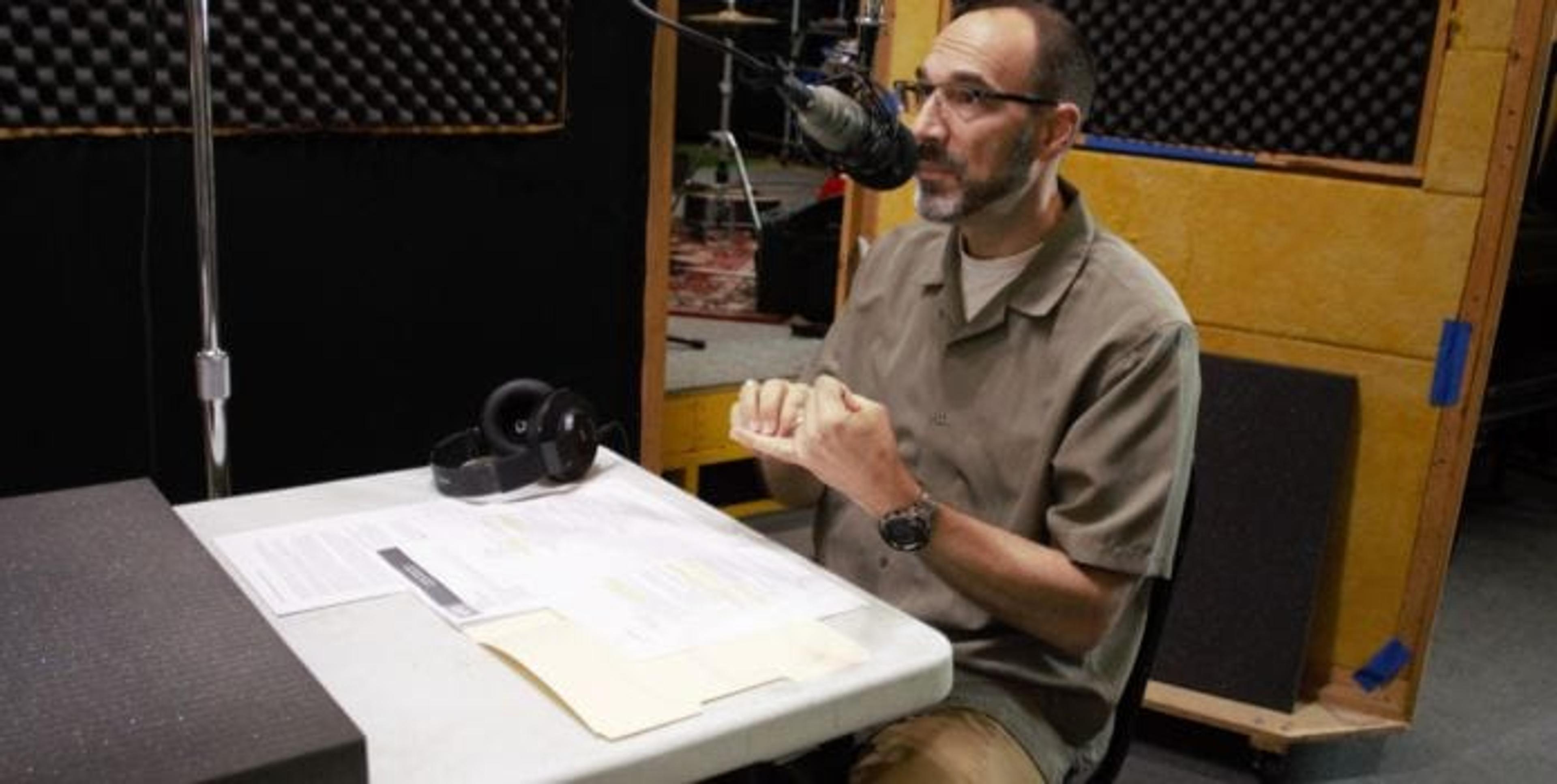Guided Imagery Meditation
| 1 min read

00:00
00:00
About the Show
On this episode, Chuck Gaidica and Dr. Duane DiFranco discuss guided imagery, and provide a walk-through exercise for listeners to follow.
“There are many different kinds of guided imagery exercises… There are some that are very specific. They take you to a beach, a forest, a mountain, or some other place. Some are less concrete, and some others are… sort of fanciful in nature. Some leave it up to you. You pick the place, just go there.” – Dr. Duane DiFranco
In this episode of A Healthier Michigan Podcast, we explore:
- The different types of guided imagery
- The importance of finding the right teacher/voice
- The addition of deep breaths
- A sample exercise for listeners to try
- Guided imagery resources:
- 10 Minutes to Relax by Paul Overman (iTunes, Amazon)
- Stop Panic – Guided Imagery Series by Marianne Zaugg,
- Stress Stop: Stress Management Training by Stuart McCalley, M.D.
- The Feeling Good Handbook and Feeling Good: The New Mood Therapy by David Burns
- The Relaxation and Stress Reduction Workbook by Matthew McKay, Martha Davis, and Elizabeth Robbins Eshelman
Transcript
Chuck: This is A Healthier Michigan Podcast, episode 17. Coming up, we discuss guided imagery, and how it can help reduce stress. Yeah, your stress.
Chuck: Welcome to A Healthier Michigan Podcast, the podcast dedicated to helping all of us navigate issues of our health, wellness, well-being, and we’re going to give you small, healthy habits and even some practice tips today, things you can do to bring your stress level down.
Chuck: Every episode, we’re talking with certified health experts from Blue Cross Blue Shield of Michigan, and we’re going to help you, and help me too, cover things like nutrition, well-being, and stress reduction. That’s what we’re doing today with Doctor Duane DiFranco. He’s a board-certified psychiatrist, currently senior medical director at Blue Care Network of Michigan. Before joining Blue Cross Blue Shield of Michigan on a full-time basis, Dr. DiFranco was an assistant clinical professor of psychiatry at U of M.
Chuck: Good to have you back.
Dr. DiFranco: Thank you, good to be here.
Chuck: After last week, I’m just relaxed.
Dr. DiFranco: Well you ain’t seen nothing yet.
Chuck: You brought my stress down. Today we want to talk about guided imagery, and before … And I know you’re going to help us with another exercise and give us some great links and tips and things. I have been through this, I guess it is stress reduction. I have a doctor, my personal physician, who had a different view, and still does, has a different view, of how and when to take your blood pressure.
Chuck: So you go to most doctors and it’s maybe the first thing, maybe it’s not even your doctor. You’ve just run up the stairs if you’re trying to be healthy, you come in, you may be stressed because of the reason you’ve come to the doctor, right? All these things are just … It’s a doctor in general, and that’s when somebody takes your blood pressure. And at most, sometimes they’ll say, “Put your feet flat on the floor,” maybe they’ll say, “Relax.”
Chuck: This doctor will say everything he needs to talk to you about up front in the meeting. When he first did this, it freaked me out. He stands up, he goes and he closes the blinds, he turns off the light in the room, he kneels next to my arm, and he says, “Relax.” He grabs my elbow of my left arm, and he’ll say, “I want you to go somewhere. Where is the best place you can imagine going?” And I would say, “I’m going to a beach in Hawaii.”
Chuck: And he would grab my elbow and wiggle it, and he would say, “You’re not there yet, you’re only in San Diego.” And he would feel me get relaxed. Then he would take my blood pressure. Now here’s what’s interesting. I’m like Mr. Average Guy blood pressure, 120/70 is my … I guess that’s about average, right?
Dr. DiFranco: Yep, that’s healthy.
Chuck: I’ve been 108/68 in that exact situation.
Dr. DiFranco: In his setting, sure.
Chuck: Is that wild? So again, it’s anecdotal and it’s me, but it’s happened more than once. It’s been 110/70, it’s been lower than Mr. Average Guy.
Dr. DiFranco: Yeah, that doesn’t surprise me at all, because that little bit of relaxation can make a big difference. And little things, little bits of pain, having a full bladder can raise your blood pressure. But the great thing about … And it sounds like you have a great doc, I don’t think you did, and I’m gonna advise you not to, mention his name. Because you do and people are gonna be lining up outside of his door.
Dr. DiFranco: Deep relaxation exercises, deep breathing, which is really the core of the three separate exercises-
Chuck: Which we did in the last episode, if somebody’s looking for-
Dr. DiFranco: Which we did in the last episode. Guided imagery, which we’re doing today, and then progressive muscle relaxation in the next one … can lower your blood pressure, can reduce your stress level, not just while you’re doing it, or a few minutes thereafter, but if you do them every day for a couple, three weeks, guess what? Your blood pressure’s low even when you’re not doing the exercises. That’s where we want to get to.
Chuck: I didn’t give you the technical explanation because that’s why you’re here. So guided imagery, out of my anecdotal little story, what can you tell us that we should be anticipating, looking for, what should be our image? Is it really what we conjure up?
Dr. DiFranco: It may be, although there’s many different kinds of guided imagery exercises. Some are very different than others, that’s why I always tell people, “Try a couple of different ones before you pass judgment on it.” Because there are some that are very specific, they take you to a beach, a forest, a mountain, some other place. Some are less concrete, and some others are even you would say sort of fanciful in nature. And some leave it up to you, you pick the place, just go there, and they just ask you questions, what is it-
Chuck: So that’s my experience.
Dr. DiFranco: That’s yours, right, exactly. What does it feel like, what does it seem like to you.
Dr. DiFranco: The one I’ve chosen, I’ve put in a little bit of the fanciful stuff in case some of the listeners are more in tune to that sort of thing. I’m a little more directive with it, I think that tends to help a little better. I’ve chosen a sort of beach scene, but mountain scenes, meadow scenes, forest scenes are very common.
Dr. DiFranco: Unlike deep breathing, which we learned last time, and progressive muscle relaxation, which we’ll learn the next time, guided imagery you really should do … You almost can’t do otherwise, with the tape playing, with someone, a voice, taking you through it. Deep breathing and progressive muscle relaxation, once you learn them, you can do them on your own, you don’t have to be listening to the tape anymore. But guided imagery really works best if you’re listening to someone take you through the exercise. And you can find these things, iTunes, Amazon.
Chuck: And this one now, when you’re done this will be episode 17 of our podcast series, where people could come back and listen over and over again.
Dr. DiFranco: That’s the intention, yep.
Chuck: And would I want to add, I’m sorry, would I want to add running water or waves splashing? If I walk in and I just say, “Hey Google, give me some rain and thunderstorm sounds,” if that’s what relaxes me I can get that.
Dr. DiFranco: Yeah, so most guided imagery recordings will have-
Chuck: That track.
Dr. DiFranco: Either a matched nature track and/or some sort of relaxing music in the background. There are others you can get that are simply Mozart set to whale song, and this kind of thing. I don’t disparage that at all, if that relaxes people, if you like listening to it, well then by all means. Just know that the research that shows that these exercises reduce stress doesn’t really show that just listening to those things is as effective as listening to someone take you through an exercise like I’m about to take folks through now.
Chuck: Okay. Anything else you wanna say before you take me to whatever place you’re gonna take me, this fanciful, outer space place?
Dr. DiFranco: It’s not quite that fanciful, but … It’s funny, you do these exercises, and time sort of goes at a different pace. So we’ll play with that a little bit in this one. But no, I think we’re ready.
Chuck: All right, I’m ready too.
Dr. DiFranco: All right.
Dr. DiFranco: Before you begin, take a brief moment and just become as comfortable as you can. You may, for example, choose to loosen your belt, unbutton your collar, perhaps take off your shoes. You can lie down or sit. If you’re sitting, sit with your feet flat on the floor, and your back comfortably upright, supported by your chair. Place your hands, fists open and palms down, on your thighs, and close your eyes.
Dr. DiFranco: This seems like a good time to experience calm, gentle peace. Place a hand on your belly. With your eyes closed, take a deep breath in. Hold it there for a second … and now release all of the air inside. Relax your abdomen. As you take slow, deep, gentle breaths, you draw the air in all the way to your waist. Breathe calmly now, slowly, deeply.
Dr. DiFranco: Breathe in over five seconds, and breathe out for five seconds. Imagine, if you will, that your body is expanding in all directions around you. With each breath in, calm peace fills you. With each breath out, you feel unnecessary tension leaving your body. Let that tension go. Let it evaporate into nothing.
Dr. DiFranco: As you relax more deeply, you may begin to notice new sensations. The support of the surface below you … new sounds … and that’s okay. Just let those sensations flow past you. They are unimportant. Focus on each breath you take, imagining each breath is drawing peaceful energy in through the bottoms of your feet, and filling you to the tops of your lungs. You are beginning to long for deep rest.
Dr. DiFranco: Imagine it is twilight … and you’re standing at the edge of a beautiful lagoon. The water at your feet is warm. Notice the sand under your feet and between your toes. What does it feel like? There are slow, gentle waves that reflect a bright moon and thousands of stars. Slowly, peacefully, you breathe in the night air.
Dr. DiFranco: Laying down, now, on the gentle waves, you find that the warm water supports you. Feel the gentle waves carry you slowly, slightly up, and gently down again. You are secure. You feel free. Drift, now, on these calm waters awhile, breathing in peace, and breathing tension away. Notice the warm water supporting you. Notice the waves bringing you slowly up and slowly down again. Notice the soft wind. You are so glad to be here.
Dr. DiFranco: Now the warmth of the sun rising at dawn settles on your cheeks. There is a deep glow all about you as the sun comes up. The glow fills the water. Let yourself become part of the warm, glowing, shallow waters. You are drawn into them, and drawn into the sun. Rest here for a while.
Dr. DiFranco: When you open your eyes and rise, you will continue to experience this warmth and this light. As you continue your activities today, you can take a deep breath, perhaps stretch, and remember this place. You can calm your mind and breathe in this warm peace.
Chuck: Okay, I’m back.
Dr. DiFranco: And that’s guided imagery.
Chuck: That is delightful. No, it’s … You know what, the only thing … First of all, it wasn’t that esoteric, you’re right. That was a really nice place to go. The only thing I can relate it to, which I immediately went to because of what you were saying, of being under the water but being supported …
Chuck: We were fortunate enough to go on a cruise last year, and in the center of the ship, not the pool where everybody’s splashing, a little side pool near the spa, underneath about four inches of water is a scalloped series of metal tubes that, if you scooch up on them, they, along with the water … It’s kind of hydro jets, but you’re not sinking … support you as if there’s a floating recliner chair.
Dr. DiFranco: Oh nice.
Chuck: But the water surrounds you, so you feel like exactly what you were describing. I went there in my mind.
Dr. DiFranco: Oh right, yeah, good.
Chuck: So it made it more real for me.
Dr. DiFranco: Good.
Chuck: You just took me on a cruise for free.
Dr. DiFranco: Yeah, again, guided imagery isn’t for everyone, and different types of guided imagery might be for some folks and not for others. It doesn’t require so much participation as it does a bit of surrender and imagination.
Chuck: Some abandon.
Dr. DiFranco: Some abandonment, yeah. And like I say, it’s not for everyone. Deep breathing and progressive muscle relaxation tend to be much more ubiquitously helpful, if you will. I think everyone can sort tune into that.
Chuck: So did you wanna give us a link or two? Because I would suggest that episode 17, this is the link to keep everybody on track.
Dr. DiFranco: Yeah, so either with … With any of these relaxation techniques, deep breathing, guided imagery, or progressive muscle relaxation, there are a number of resources out there, kind of an almost dizzying amount. I’ve spent some time going through many of them, and there are some that I can recommend that I think follow the research-proven technique a little more closely.
Dr. DiFranco: Some names for you, for iTunes or Amazon. Paul Overman, he does a series called 10 Minutes to Relax. There’s different CDs with different exercises on them. Lee Riley, R-I-L-E-Y, has another set of similar series. Marianne Zaugg, Z-A-U-G-G. And then there’s Stuart McCalley has a series called StressStop that’s focused specifically for folks with insomnia. The exercises are more brief than what I just went through, but follow some of the same principles.
Dr. DiFranco: And then a couple of books. These books aren’t necessarily for relaxation techniques, guided imagery, and that sort of thing, but more on the cognitive end of things. David Burns is an author, he’s written The Feeling Good Handbook and a newer release, Feeling Good: The New Mood Therapy. Highly recommended.
Dr. DiFranco: There’s also a good stress relief manual out there by Matthew McKay and Martha Davis called The Relaxation and Stress Reduction Workbook. These are the things, as I go through everything, that’s available that I recommend. But whatever works for you, that’s what you should use.
Chuck: That’s great that you’ve vetted some of those for us too. Thanks, doc. It’s good to have you back, and we will get together again next time. Let me just remind you, this is A Healthier Michigan Podcast brought to you by Blue Cross Blue Shield of Michigan. If you like the show, if you like this episode or other episodes you wanna go back and listen to, let me suggest last one, episode 16 was centered with deep breathing and an exercise you can participate in. Maybe you wanna listen to that one over again.
Chuck: This one is episode 17, just so you know. Check us out at ahealthiermichigan.org/podcast, and those names of various authors and people who’ve put together some of their own CDs and books, all of that will be posted for you as well, ahealthiermichigan.org/podcast. You can also leave us a review or a rating on iTunes or Stitcher. You get all your episodes downloaded to your smartphone or your other devices like your tablet.
Chuck: So we want you to come back next time. Give us a good thumbs up, and also do this for us: let others know, especially if there’s somebody in the family who you think can benefit from this, let them know that this podcast series is underway. Next time when you join us, Dr. Duane DiFranco will be back. We’ll be talking about progressive muscle relaxation and how we can use it to reduce our stress. Take good care.





